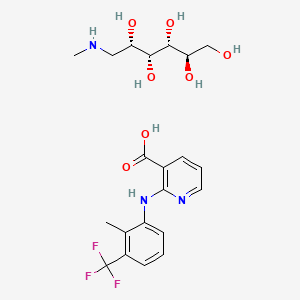D0939 | flunixin meglumine
| Toxicity | Dose | Time | Species | Model | Method | Action | Positive criterion | Reference |
|---|---|---|---|---|---|---|---|---|
| MEMBRANE POTENTIAL | 9.02±0.00 | human | qHTS-HepG2 | MMP assay | decrease | IC50 | 163 | |
| MEMBRANE POTENTIAL | 7.4 | human | HepG2 | MMP assay | decrease | IC50 | 163 | |
| MEMBRANE POTENTIAL | 5.77±4.59 | rat | hepatocytes | MMP assay | decrease | IC50 | 163 | |
| Pictogram | Signal | Statements | Precautionary Statement Codes |
|---|---|---|---|
     |
Danger |
Aggregated GHS information provided by 206 companies from 16 notifications to the ECHA C&L Inventory. Each notification may be associated with multiple companies. Reported as not meeting GHS hazard criteria by 1 of 206 companies. For more detailed information, please visit ECHA C&L website Of the 15 notification(s) provided by 205 of 206 companies with hazard statement code(s): H301 (79.51%): Toxic if swallowed [Danger Acute toxicity, oral] H315 (19.51%): Causes skin irritation [Warning Skin corrosion/irritation] H318 (35.12%): Causes serious eye damage [Danger Serious eye damage/eye irritation] H319 (63.41%): Causes serious eye irritation [Warning Serious eye damage/eye irritation] H330 (77.07%): Fatal if inhaled [Danger Acute toxicity, inhalation] H335 (55.12%): May cause respiratory irritation [Warning Specific target organ toxicity, single exposure Respiratory tract irritation] H372 (24.39%): Causes damage to organs through prolonged or repeated exposure [Danger Specific target organ toxicity, repeated exposure] H411 (77.56%): Toxic to aquatic life with long lasting effects [Hazardous to the aquatic environment, long-term hazard] Information may vary between notifications depending on impurities, additives, and other factors. The percentage value in parenthesis indicates the notified classification ratio from companies that provide hazard codes. Only hazard codes with percentage values above 10% are shown. |
P260, P261, P264, P270, P271, P273, P280, P284, P301+P310, P302+P352, P304+P340, P305+P351+P338, P310, P312, P314, P320, P321, P330, P332+P313, P337+P313, P362, P391, P403+P233, P405, and P501; (The corresponding statement to each P-code can be found at the GHS Classification page.) |
| (2R,3R,4R,5S)-6-(methylamino)hexane-1,2,3,4,5-pentaol 2-(2-methyl-3-(trifluoromethyl)phenylamino)nicotinate | (2R,3R,4R,5S)-6-(methylamino)hexane-1,2,3,4,5-pentol;2-[2-methyl-3-(trifluoromethyl)anilino]pyridine-3-carboxylic acid | 1-Deoxy-1-(methylamino)-D-glucitol 2-(2-methyl-3-(perfluoromethyl)anilino)nicotinate |
| 1-deoxy-1-(methylazaniumyl)-D-glucitol 2-{[2-methyl-3-(trifluoromethyl)phenyl]amino}nicotinate | 2-((2-Methyl-3-(trifluoromethyl)-phenyl)amino)-3-pyridinecarboxylic acid with meglumine compounded | 2-((2-methyl-3-(trifluoromethyl)- phenyl)amino)-3-pyridinecarboxylic acid with meglumine compounded |
| 2-(alpha(sup 3),alpha(sup 3),alpha(sup 3)-Trifluoro-2,3-xylidino)nicotinic acid compound with 1-deoxy-1-(methylamino)-D-glucitol (1:1) | 2-[[2-Methyl-3-(trifluoromethyl)phenyl]amino]-3-pyridinecarboxylic acid meglumine salt | 2-{[2-methyl-3-(trifluoromethyl)phenyl]amino}nicotinic acid--1-deoxy-1-(methylamino)-D-glucitol (1/1); |
| 3-Pyridinecarboxylic acid, 2-((2-methyl-3-(trifluoromethyl)phenyl)amino)-, compd. with 1-deoxy-1-(methylamino)-D-glucitol (1:1) | 42461-84-7 | 461F847 |
| 8Y3JK0JW3U | AB00920714_05 | AB00920714_06 |
| AB2000512 | AC-6012 | AKOS015895954 |
| API0025954 | BSPBio_002558 | Banamine |
| Banamine (Veterinary) | Banamine [vetarynary] (TN) | C-22876 |
| C14H11F3N2O2.C7H17NO5 | C21H28F3N3O7 | CCG-213338 |
| CHEBI:76144 | CHEMBL1733447 | CS-2460 |
| CTK8F9789 | Certified Reference Material | D-Glucitol, 1-deoxy-1-(methylamino)-, 2-((2-methyl-3-(trifluoromethyl)phenyl)amino)-3-pyridinecarboxylate (salt) |
| D04216 | EINECS 255-836-0 | FLUNIXIN MEGLUMINE |
| FT-0626443 | Flumeglumine | Flunixin (meglumine) |
| Flunixin Meglumine [USAN] | Flunixin Meglumine, Pharmaceutical Secondary Standard | Flunixin N-methylglucanine |
| Flunixin meglumin | Flunixin meglumine (USP) | Flunixin meglumine [USAN:USP] |
| Flunixin meglumine, >=98% (HPLC) | Flunixin meglumine, European Pharmacopoeia (EP) Reference Standard | Flunixin meglumine, United States Pharmacopeia (USP) Reference Standard |
| Flunixin-S | HMS2093I10 | HMS2234K05 |
| HY-B0386 | K-8817 | KS-000010G2 |
| KS-5126 | LS-71360 | MGCCHNLNRBULBU-WZTVWXICSA-N |
| MLS001333159 | MLS002153985 | NCGC00180889-01 |
| NSC-759583 | NSC759583 | Pharmakon1600-01505113 |
| PubChem15394 | Q-201124 | Q27145782 |
| SC-18614 | SCHEMBL43691 | SMR000875279 |
| SPECTRUM1505113 | SR-05000001901 | SR-05000001901-1 |
| SR-05000001901-3 | SW196448-3 | Sch 14714 meglumine |
| Sch-14714 meglumine | UNII-8Y3JK0JW3U | finadyne |
| flunixin-meglumin | s2108 |

